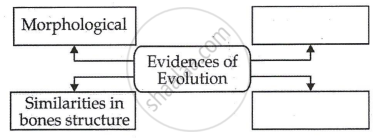Advertisements
Advertisements
Question
Write names of some vestigial organs in the human body.
Solution
The human body contains several vestigial organs, including the tailbone (coccyx), wisdom teeth, and body hairs.
RELATED QUESTIONS
Give two examples of vestigial organs in human beings and plants.
(a) Select the homologous structures from the combinations given below:
(i) Forelimbs of whales and bats
(ii) Tuber of potato and sweet potato
(iii) Eyes of octopus and mammals
(iv) Thorns of Bougainvillea and tendrils of Cucurbita
(b) State the kind of evolution they represent.
If you are asked to select a group of two vegetables, out of the following, having homologous structures which one would you select?
(a) Carrot and radish
(b) Potato and sweet potato
(c) Potato and tomato
(d) Lady finger and potato
How analogy and homology considered as an evidence in support of evolution ?
Can the wing of a butterfly and the wing of a bat be considered homologous organs? Why or why not?
Explain the terms analogous and homologous organs with examples.
Give the importance of fossil in support of organic evolution
Explain with an example for the given, how the following provides evidence in favor of evolution in organisms :
Fossils
Name the scientists who Discovered the fossil of Australopithecus
The forelimbs of a frog, a bird and a man show the same basic design (or basic structure) of bones. What name is given to such organs?
Name two animals having homologous organs and two having analogous organs. Name these organs.
The presence of which of the following types of organs in two organisms indicates that they are derived from the same ancestor?
(a) analogous organs
(b) respiratory organs
(c) digestive organs
(d) homologous organs
The organs P and Q of two animals have different structures but similar functions. On the other hand, the two organs R and S of two other animals have the same basic structure but different functions.
(a) What are the organs like P and Q known as?
(b) Name the organs like P and Q. Also name the animals which have such organs.
(c) What are the organs like R and S called?
(d) Name the organs like R and S. Also name the animals which have such organs.
What do we call the degenerated or partially developed useless organs in living organisms? Enlist such organs in human body? How the same organs are useful in other animals?
Vestigial organ ______ present in human body is proof of evolution.
Write short notes based upon the information known to you.
Connecting link
Answer the following question.
Wisdom teeth : Vestigial organs :: Lungfish : ....................
Explain any three molecular (genetic) evidences in favour of organic evolution.
Find an odd one out.
Appendix : vestigial organ : : Peripatus : ____________
Define the evidence of evolution shown in the figure.

Homologous organs and vestigial organs are examples of ______ type of evidence in evolution.
Select the CORRECT match.
Tendons and ligaments are examples of ______.
The process of mating of individuals, which are more closing related than the average of the population to which they belong is called ______.
Flippers of Penguins and Dolphins are examples of:
The study of fossil evidence of evolution is called ______
What were the characteristics of life forms that had been fossilised?
Did aquatic life forms get fossilised? If, yes where do we come across such fossils?
While creation and presence of variation is directionless, natural selection is directional as it is in the context of adaptation. Comment.
The evolutionary story of moths in England during industrialisation reveals, that 'evolution is apparently reversible'. Clarify this statement.
You have studied the story of Pepper moths in England. Had the industries been removed, what impact could it have on the moth population? Discuss.
Give a scientific reason.
Morphological evidences suggest that dog, sheep and wolf have a common origin.
Find the odd one out:
Complete the following conceptual picture:

Give examples of homologous organs and analogous organs in plants.
Pick the odd man out:
